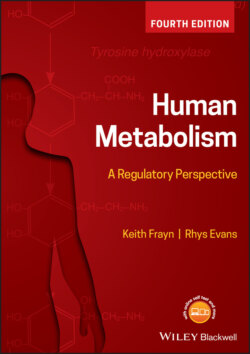Читать книгу Human Metabolism - Keith N. Frayn - Страница 30
Box 1.5 Tricarboxylic acid cycle: overall scheme
ОглавлениеAcetyl-CoA is oxidised by losing electrons (H− ions) and ends up as CO2. The electrons are captured by NAD+ and FAD to become their reduced forms, NADH and FADH2 (and they will in turn pass these electrons on to other electron carriers in the electron transport chain, becoming re-oxidised themselves and ready for further electron carriage). This is achieved in a step-wise fashion by the TCA or Krebs cycle. In addition, as part of the controlled release of energy, one of the steps of the TCA cycle does not have sufficient energy to reduce NAD+ or FAD but does have sufficient energy to phosphorylate GDP to GTP. One acetyl-CoA molecule reduces one FAD and three NAD+ molecules.
The stoichiometry is precise, such that both the carbons of the acetyl group are oxidised (though as shown by radiolabelling experiments, not the actual two carbon atoms that entered the cycle), hence all their useful energy is extracted, resulting in two carbon dioxide molecules as ‘waste’ products. The NADH and FADH2 will subsequently be re-oxidised by passing on the electron(s) they carry down the redox proteins of the electron transport chain, regenerating NAD+ and FAD in the process for further electron carriage; by coupling this sequential oxidation-reduction to phosphorylation of ADP to ATP (‘oxidative phosphorylation’), a common energy carrier for diverse cellular functions (ATP) is synthesised (see below).
An important point about the TCA cycle is that its intermediates are not specifically dedicated to the cycle – they are also used for other purposes in several other metabolic pathways (e.g. amino acid metabolism; porphyrin synthesis; purine nucleotide metabolism). Processes which utilise TCA cycle intermediates and hence deplete them are termed ‘cataplerotic’ whilst processes which replenish them are termed ‘anaplerotic.’ In order for a substance to be anaplerotic it must have more than two carbons (or equivalent): acetyl groups cannot replenish the cycle because both their carbons (equivalent) are oxidised by the cycle (2 × CO2) and no net gain of carbon occurs. Since fatty acids represent a chain of 2-carbon groups (they are, effectively, a storage form of acetyl groups – hence their mostly even numbers of carbons), when fatty acids are used for energy (e.g. during starvation) they are broken back down to 2-carbon acetyl groups (by β-oxidation) and cannot therefore be anaplerotic – indeed reliance on fatty acids for oxidation does lead to cataplerosis: if a cell were to derive its energy entirely from fatty acids, eventually cataplerotic depletion of TCA cycle intermediates would occur due to ongoing utilisation of the intermediates by other pathways, combined with the inability of the fatty acids (acetyl groups) to ‘top up’ the same cycle intermediates. The same applies for ketone bodies (acetoacetate, 3-hydroxybutyrate) which are 4-carbon compounds but effectively represent two acetyl groups joined together – a transport form of acetyl-CoA; their utilisation first requires them to be converted back into acetyl-CoA, and they cannot enter the TCA cycle as 4-carbon compounds. Anaplerosis has to occur from carbohydrates or (glucogenic) amino acids, which can bypass the PDH step and insert 4-carbon intermediates (e.g. oxaloacetate; derived from pyruvate) into the cycle. The importance of these anaplerotic pathways, and the enzymes that achieve them, to maintain cellular metabolic efficiency is now well recognised. See later, Box 5.3, for more information.
